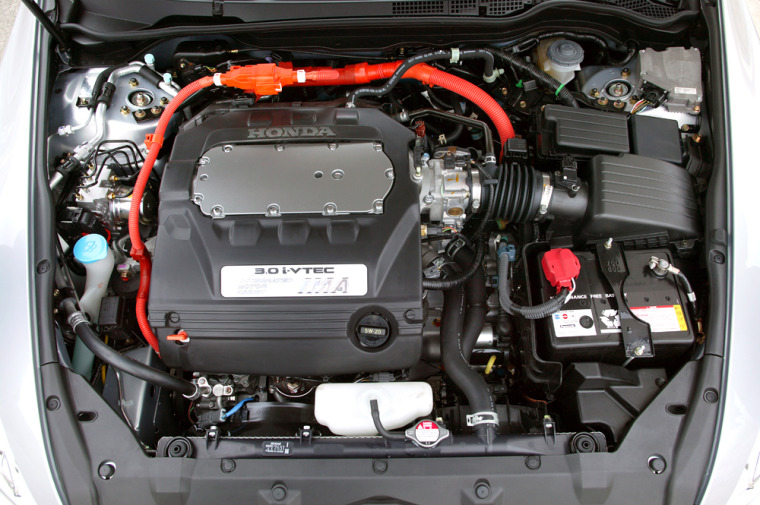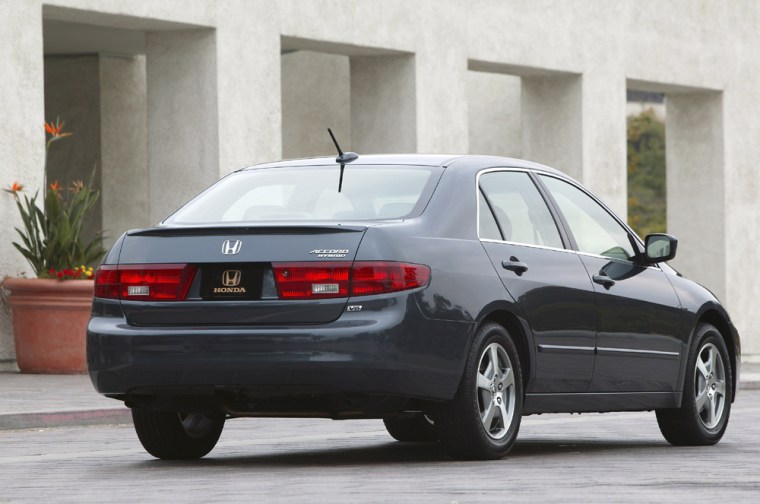Honda proves a hybrid can have other benefits besides good fuel economy — there's great performance to boot.
Sure, gas-electric hybrid vehicles get better fuel economy than standard gas-powered cars, but hybrids must sacrifice performance to achieve the best possible miles per gallon, right? Well, no longer. Honda's new Accord Hybrid not only offers the best fuel economy of the Accord lineup, it also boasts the highest performance of the line, which just happens to be one of the best-selling cars in America year in and year out.
Honda was the first automaker to offer a hybrid vehicle in the United States. The tiny Insight went on sale in the 2000 model year, boasting stunning mpg ratings. Although Insight sales have dropped to around 1,000 units per year worldwide, it still tops the annual EPA fuel economy list. Honda officials indicate they have no plans to drop the slow-selling little coupe.
The Civic Hybrid went on sale in March 2002, marking the first time a mainstream vehicle had been converted to run on a hybrid powertrain. Now with Honda adding a hybrid version of the Accord, the Japan-based automaker is the only car company to offer three hybrid models.
The Honda Accord already offers a powerful and efficient V6 engine in its sedan. With 240 horsepower, the Accord is comparable to its competitors, offering good performance and strong acceleration. And even with that performance, the Accord V6 achieves a respectable 21 mpg in the city and 30 mpg on the highway.
However, with the Accord Hybrid Honda has improved both performance and fuel economy over the standard Accord V6.
More power, better fuel economy
The stats: An Accord Hybrid produces 255 horsepower and 232 lb-ft of torque, 90 percent of which is available below 4000 rpm. This represents a 6.3 percent increase in horsepower, while torque is up 9.4 percent. That's good enough to knock about half a second off the time it takes to reach 60 mph from a standstill.
While performance of the new Accord Hybrid is impressive, so are its fuel economy improvements. More stats: Fuel economy in the city is rated at 30 mpg; highway is 37 mpg. This is a 43 percent improvement in the city, 23 percent on the highway over the standard Accord V6 sedan. To put this in perspective, a Honda Civic (not the Civic Hybrid) gets 31 mpg city/38 mpg highway. Maximum range on one tank of fuel increases to by 23 percent to 633 miles.
So how does Honda do it? Getting more power and better fuel economy was not as simple as attaching an electric motor to the standard Accord V6 engine. Some impressive technology went into this achievement. In the Accord Hybrid, the gasoline engine needed to be efficient as well as provide high performance.
Variable Cylinder Management (VCM)
The 3.0-liter i-VTEC V6 engine is based on the standard Accord's V6. The engine was modified to reduce space and weight, and to allow for the Integrated Motor Assist (IMA) motor to be installed. More on the IMA in a moment.

The most unique feature of this V6 engine is the Variable Cylinder Management (VCM) system. VCM will shut off fuel to three of the six cylinders when the full V6 performance is not needed. During startup and acceleration the engine runs on all six cylinders. However, during highway cruising, downhill driving or other instances where engine load is low, combustion in the rear bank of three cylinders is halted. When full power is needed, valves are opened instantly to allow fuel back into the idled cylinders.
In addition to the VCM, the Accord Hybrid's V6 features "idle stop." Similar to the Insight and Civic Hybrid, the gasoline engine will turn itself off when the car comes to a stop from a speed above 10 mph. The engine turns off when the car slows to 10 mph on its way to a stop, restarting immediately when the brake pedal is released.
Honda engineers have calculated that the VCM system is responsible for 15 percent of the city-driving fuel savings and 57 percent of the fuel savings on the highway.
Integrated Motor Assist (IMA)
The other half of the hybrid system is Honda's Integrated Motor Assist system. Already the third generation of this system, it features a very thin brushless electric motor mounted between the gasoline engine and the automatic transmission. The electric motor in the Accord Hybrid produces 16 horsepower and 100 lb-ft of torque.
Part of the IMA system is the intelligent power unit (IPU), which stores the electric energy in a compact battery pack and controls the flow of electricity to and from the electric motor. During deceleration and braking, the electric motor acts as a generator, recharging the battery pack. More than 95 percent of the energy generated in braking is recovered to store in the batteries.
Also key to this hybrid system is the new 5-speed automatic transmission. This transmission is thinner and lighter than the one used in the Accord V6, and provides quicker shift response during acceleration.
Other fuel-saving moves
In addition to the powertrain advances in the Accord Hybrid, Honda engineers made a number of other adjustments.
To counter the added weight from the electric motor and battery pack, the Accord Hybrid features an aluminum hood, aluminum suspension components and unique lightweight alloy wheels. In place of a spare tire, Honda provides a flat-tire repair system. Still, the Accord Hybrid weighs in about 175 lbs. more than the Accord EX V6.
A small rear spoiler and a combination AM/FM/XM radio antenna have also been added to improve aerodynamics.
Everything working together
This very complex system runs very smoothly, applying power when and where it is needed to achieve the best efficiency. There are five different modes under which the hybrid system can operate:
- Initial acceleration from stop — all six cylinders are in operation, no boost from the electric motor. No indicator lights in the instrument panel are lit.
- Stronger acceleration — all six cylinders are in operation and the electric motor is providing additional boost. Blue bars in the instruments light indicate how much assist is coming from the electric motor.
- Cruising — three cylinders are deactivated and electric motor provides no boost. Green "ECO" lights in the instrument panel indicate the VCM system is operating.
- Mild acceleration from cruising speed — three cylinders remain deactivated, but electric boost is added for more power. ECO light remains on, but blue bars light showing boost from electric motor.
- Deceleration — three cylinders remain deactivated and kinetic energy is recovered by the electric motor. ECO light remains on, but green bars light indicate the amount of charge going to the battery pack.
What we found most surprising while driving the Accord Hybrid was the seamlessness of the entire operation—shutting off cylinders, adding electric boost — there was no noticeable change in the drive. If the indicator lights had been covered up, one would have thought the Hybrid was a standard Accord V6.
The only thing that felt a bit unusual was the engine being shut off while stopped — and there is a slight vibration when the engine restarts, although it is barely noticeable and not intrusive.
During our press drive, we drove both the Accord EX V6 and the Accord Hybrid on the same basic route. The Accord Hybrid was noticeably quicker with very strong acceleration, almost feeling lighter when the electric motor provided full boost. According to the gauges, the Accord EX V6 averaged about 23 mpg, while the Accord Hybrid averaged just over 30 mpg.
Marketing
Honda has taken a different tack for marketing the Accord Hybrid. Billed as the top-of-the-line Accord, pricing is expected to be around $30,000. This is about $3,500 more than an Accord EX-V6. Based on gas priced around $2.00 per gallon and an average of 15,000 miles driven per year, it would take more than eight years to make an Accord Hybrid purchase worthwhile, based solely on saving money on gas.
But there's more to this car than just good fuel economy. One also has to take into account the added performance, as well as the fact that this car is fully loaded with leather trim, heated seats, XM Satellite radio and dual-zone climate control—the only factory option is a satellite navigation system.
The Accord Hybrid is not easily differentiated from a standard Accord. The hybrid badge on the rear trunk lid is the only identifier on the car, both outside and inside. Other exterior differentiators include the unique front grille and tires that are a bit wider (to handle the extra weight).
Expect to see plenty of advertising for the Accord Hybrid. Honda plans to use all of its Accord advertising budget to extol the hybrid's virtues; it arrives in showrooms on December 3.
